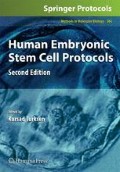Abstract
Human embryonic stem cells (hESC) involve long-term cultures that must remain undifferentiated. The real-time PCR (RT-PCR) technique allows the relative quantification of target genes, including undifferentiation and differentiation markers when referred to a housekeeping control with the addition of a calibrator that serves as an internal control to compare different lots of reactions during the time. The main aspects will include a minimal number of cells to be analyzed, genes to be tested, and how to choose the appropriate calibrator sample and the reference gene. In this chapter, we present how to apply the RT-PCR technique, protocols for its performance, experimental set-up and software analysis, as of the gene expression of hESC lines in consecutive passages for long-term culture surveillance.
Access this chapter
Tax calculation will be finalised at checkout
Purchases are for personal use only
References
Liew, C. G., Moore, H., Ruban, L., Shah, N., Cosgrove, K., Dunne, M., and Andrews P. (2005) Human embryonic stem cells: possibilities for human cell transplantation. Ann Med 37, 521–32.
Yu, J., and Thomson, J. A. (2006) Embryonic stem cells. In Regenerative Medicine. NIH, eds. Terese Winslow, pp 1–12.
Guhr, A., Kurtz, A., Friedgen, K., and Loser, P. (2006) Current state of human embryonic stem cell research: an overview of cell lines and their use in experimental work. Stem Cells 24, 2187–91.
The International Stem Cell Initiative: Characterization of human embryonic stem cell lines by the International Stem Cell Initiative. (2007) Nat Biotechnol 25, 803–16.
Valbuena, D., Galán, A., Sánchez, E., Poo, M. E., Gómez, E., Sánchez-Luengo, S., Melguizo, D., Garcia, A., Ruiz, V., Moreno, R., Pellicer, A., and Simón, C. (2006) Derivation and characterization of three new Spanish human embryonic stem cell lines (VAL -3 -4 -5) on human feeder and in serum-free conditions. Reprod Biomed Online 13, 875–86.
Schuldiner, M., Yanuka, O., Itskovitz-Eldor, J., Melton, D. A., and Benvenisty, N. (2000) Effects of eight growth factors on the differentiation of cells derived from human embryonic stem cells. Proc Natl Acad Sci USA 97, 11307–12.
Henderson, J. K., Draper, J. S., Baillie, H. S., Fishel, S., Thomson, J. A., Moore, H., and Andrews, P. W. (2002) Preimplantation human embryos and embryonic stem cells show comparable expression of stage-specific embryonic antigens. Stem Cells 20, 329–337.
Babaie, Y., Herwig, R., Greber, B., Brink, T. C., Wruck, W., Groth, D., Lehrach, H., Burdon, T., and Adjaye, J. (2007) Analysis of Oct4-dependent transcriptional networks regulating self-renewal and pluripotency in human embryonic stem cells. Stem Cells 25, 500–10.
Xu, R. H., Peck, R. M., Li, D. S., Feng, X., Ludwig, T., and Thomson, J.A. (2005) Basic FGF and suppression of BMP signaling sustain undifferentiated proliferation of human ES cells. Nat Methods 2, 185–190.
Eisenberg, E., and Levanon, E. Y. (2003) Human housekeeping genes are compact. Trends Genet 19, 362–5.
Lee, P. D., Sladek, R., Greenwood, C. M., and Hudson, T. J. (2002) Control genes and variability: absence of ubiquitous reference transcripts in diverse mammalian expression studies. Genome Res 12, 292–7.
Hsiao, L. L., Dangond, F., Yoshida, T., Hong, R., Jensen, R.V., Misra, J., Dillon, W., Lee, K. F., Clark, K. E., Haverty, P., Weng, Z., Mutter, G. L., Frosch, M. P., Macdonald, M. E., Milford, E. L., Crum, C. P., Bueno, R., Pratt, R. E., Mahadevappa, M., Warrington, J. A., Stephanopoulos, G., and Gullans, S. R. (2001) A compendium of gene expression in normal human tissues. Physiol Genomics 7, 97–104.
Warrington, J. A., Nair, A., Mahadevappa, M., and Tsyganskaya, M. (2000) Comparison of human adult and fetal expression and identification of 535 housekeeping/maintenance genes. Physiol Genomics 2, 143–7.
Synnergren, J., Giesler, T. L., Adak, S., Tandon, R., Noaksson, K., Lindahl, A., Nilsson, P., Nelson, D., Olsson, B., Englund, M. C., Abbot, S., and Sartipy, P. (2007) Differentiating human embryonic stem cells express a unique housekeeping gene signature. Stem Cells 25, 473–80.
Al-Bader, M. D., and Al-Sarraf, H. A. (2005) Housekeeping gene expression during fetal brain development in the rat-validation by semi-quantitative RT-PCR. Brain Res Dev Brain Res 156, 38–45.
Szabo, A., Perou, C. M., Karaca, M., Perreard, L., Quackenbush, J. F., and Bernard, P. S. (2004) Statistical modeling for selecting housekeeper genes. Genome Biol 5, R59.
Author information
Authors and Affiliations
Editor information
Editors and Affiliations
Rights and permissions
Copyright information
© 2009 Humana Press, a part of Springer Science+Business Media, LLC 2006
About this protocol
Cite this protocol
Galán, A., Simón, C. (2009). Monitoring Stemness in Long-Term hESC Cultures by Real-Time PCR. In: Turksen, K. (eds) Human Embryonic Stem Cell Protocols. Methods in Molecular Biology, vol 584. Humana Press. https://doi.org/10.1007/978-1-60761-369-5_8
Download citation
DOI: https://doi.org/10.1007/978-1-60761-369-5_8
Published:
Publisher Name: Humana Press
Print ISBN: 978-1-60761-368-8
Online ISBN: 978-1-60761-369-5
eBook Packages: Springer Protocols

